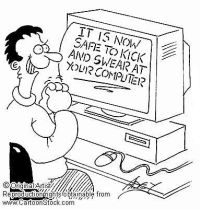 Over the years I have seen numerous examples of poor computer use and maintenance ranging from simply outdated applications to damaged hardware by water, coffee, soda, fire…you name it.
Over the years I have seen numerous examples of poor computer use and maintenance ranging from simply outdated applications to damaged hardware by water, coffee, soda, fire…you name it.
In hopes that at least a few people will read this and by doing so improve their own computing experience I have put together a little guide on basic, somewhat fundamental things every computer owner should know and do. I guarantee that by following these basic steps you will eliminate majority of your daily frustrations and make the graphic above a thing of the past. 😉
Hardware care basics
1. Computer is a delicate piece of electronic equipment with some moving parts and as such it is important NOT to drop it, kick it, shake it, get it in contact with dust, magnets, excessive heat or any liquids.
2. It is NOT meant to be used as a plate (or a drink coaster) so don’t eat above it or use your greasy fingers to type and touch the screen, that’s not only bad for the computer but it is simply disgusting (especially for us IT folks who have to fix it).
3. It is NOT a litter box or a pillow for your cat or small dog. Hairs and other particles entering your computer can cause damage.
4. It is NOT a toy for your toddler.
5. Do NOT use it in areas surrounded with water: pool, hot tub, jacuzzi; bathroom (for other reasons as well); on the beach (sand is also a no no).
6. For laptop owners: let the battery do its job every once in a while and actually power your computer. Don’t have it plugged in 24/7 or your battery will stop working. Also, on the other hand, do not let your battery die with machine turned on – this could corrupt your data and software.
7. If not using your computer for several hours or longer (over night, away on weekend) turn it off.
Software care basics
1. Operating System (OS) is your friend so don’t abandon it. If you are running Windows, make sure you get Microsoft Updates* (automate them); running OS X, get Apple’s Software Updates* (automate them).
2. Update applications. On Windows side you can use tools such as FileHippo (other tools are available as well). For Macs since most apps come from Apple they would be covered under the above mentioned Software Updates.
3. Install and update an anti-virus solution. This is just common sense.
4. Run anti-malware software regularly (CCleaner, Malwarebytes, Ad-Aware to name a few)
5. Make sure you have a firewall running.
6. Don’t download the internet. Pick and choose applications you will install on your machine. Get stuff you know is safe, secure, stable and does what you need it to do.
An absolute must for all
Another very important point to make (less related to owning a computer, but more to intelligent computing):
Backup your files!
This includes documents, photos, videos, music and any other file you find valuable. You can always replace a computer or have it repaired, but losing a document that you worked on for weeks or months could be very frustrating.
* These are general suggestions, if you need help configuring your operating system to auto update leave a comment and I will gladly help you.